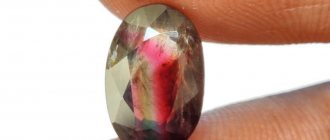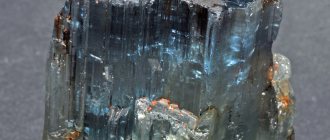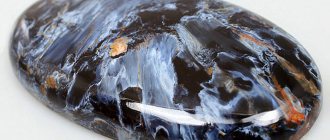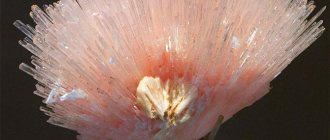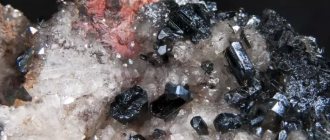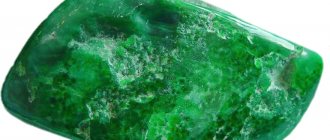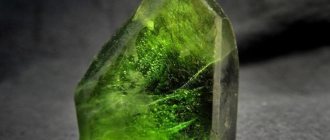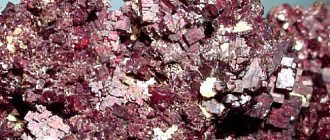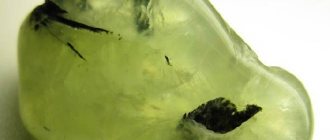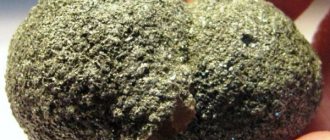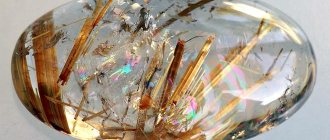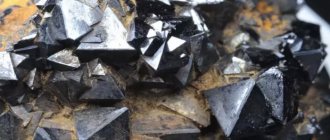Tourmaline has long been classified as a gemstone due to its similarity. The green mineral was first discovered in the early 1500s and was mistaken for an emerald. Due to the rich variety of colors of the stone, it was often confused with rubies and sapphires.
Bracelet “Lion No. 1” made of tourmaline, garnet and obsidian. Collection "Zodiac". Handmade. Designer jewelry from My lovely SPIRIT.
The diversity of tourmaline has contributed to the confusion: gemologists count more than fifty shades of the gemstone. Only in 1711, the Dutchman Paul Hermann, who collected a collection of brightly colored minerals in Ceylon, published a catalog in which “peridot tourmaline” appeared. It was a two-color stone with a green outer layer and a ruby-red core.
The mineral received its name from the Sinhalese, the indigenous population of Sri Lanka. The locals called it turamali or toramalli, which meant "mixed-colored gem" or "something small from the Earth." .
The color of tourmaline varies from monotonous to a multi-colored rainbow and depends on the amount and type of metal in it. Red, blue, green, black, pink, yellow, brown - you will find a mineral to suit every mood.
Historical reference
First, it’s worth finding out whether tourmaline is a semi-precious or precious stone.
This mineral is a semi-precious stone and belongs to the group of aluminosilicates. No one today can say exactly when tourmaline was discovered. It was definitely known about it and its magical, therapeutic properties already in the times of Ancient Rome. It is difficult to say whether the Romans were the first to discover tourmaline. Scientists are inclined to believe that this happened even earlier.
Byzantine craftsmen were also familiar with this mineral. Tourmaline was also known in Rus' back in the 14th century. Europeans for a long time did not attach any importance to this mineral. Increased interest in it arose only during the era of the Great Geographical Discoveries. Dutch sailors brought interesting pebbles to Europe from Ceylon. Demand for the product grew very quickly. This led to the rich Ceylon deposits being plundered by greedy traders wanting to find expensive rubies and emeralds.
There are two interpretations of the name of the stone, which were translated from the dialect of the inhabitants of Ceylon:
- ash-attracting stone;
- magical multi-colored stone.
In history there is a mention of a legendary stone whose shape resembles a bunch of grapes. They say that Cleopatra presented such a valuable gift to Caesar. After some time, the trace of this gem is lost. Tourmaline has come a long way until it came to the attention of King Gustav VIII of Sweden. He gave the stone to Catherine the Second and many thought for a long time that it was a real ruby.
Esoterics and black tourmaline
Since its discovery, black tourmaline has acquired many legends, traditions and received a bunch of magical properties. Due to its color, it is generally believed that it acts as a portal to a parallel world. Some esotericists even associate a special crystal structure with this and warn that often, in order to save money, onyx is used instead of black tourmaline, which accordingly reduces all magical properties to nothing.
Also, the mystery of the black color was given even by the fact that the latest research by astrophysicists led to the conclusion that without an invisible unifying substance, galaxies would have ceased to exist long ago. This is confirmed by mathematical calculations indicating that stellar islands do not have enough of their own gravity to maintain the spiral structure of stars for millions of years in a row. This invisible substance is called Black Matter, and not the fixed, but supposedly existing radiation of Black Energy.
Which was immediately associated with tourmalines with a similar color. According to esotericists, the gem is associated with these substances and matters. The phenomenon appears as a sometimes noticeable eye with a vertical pupil, as if floating inside the stone itself. However, to come across such an amulet is very rare, and most often it is found not in black, but in green and is called an asterism.
Where are tourmalines mined?
Tourmaline is a volcanic mineral. Most deposits are located where there is high volcanic activity. Veins with crystal deposits form in granites, metamorphic rocks and skarns.
80% of all tourmalines come to the world market from Brazil. This country leads the world in stone exports. In Brazil, specimens of different shades are mined. Quite often you can hear them called Brazilian rubies and emeralds, sapphires.
A lot of jewelry crystals are mined on the North American continent. Such a product is valued by craftsmen and collectors, but the total deposits of tourmaline cannot be called large. Now specialists are actively developing deposits in the African province of Nuristan. Tanzania, Mozambique and Zimbabwe have great potential for stone mining. Here they find small tourmalines of a unique blue-green hue, which is so prized on the market.
There are a number of other countries where tourmalines are mined. Deposits were discovered in:
- USA;
- Canada;
- Madagascar;
- Sri Lanka.
Many people simply do not know where this unique mineral is mined in Russia. The Malkhan deposit in the Trans-Baikal Territory is a real leader in tourmaline mining. Veins with crystal deposits cover an area of almost 60 kilometers. Experts discovered tourmalines of different colors in 40 veins. The rest even contain amethysts. In Russia, this is the only deposit where stone mining is carried out on an industrial scale. In the Malkhan deposit there are varieties of jewelry and collection tourmaline.
Place of Birth
There are numerous deposits of tourmaline in many parts of the world.
The richest deposits are:
- Sri Lanka;
- Brazil;
- China;
- Myanmar;
- Madagascar;
- India;
- Angola;
- Mozambique;
- Tajikistan;
- Italy;
- Canada;
- Switzerland;
- Afghanistan;
- USA;
- SOUTH AFRICA.
In Russia, gem-quality tourmalines are mined:
- in Karelia;
- in Transbaikalia;
- on the Kola Peninsula.
Deposits and rock processing
There are quite a lot of tourmaline deposits in the world. The most famous and largest producing countries:
- Sri Lanka;
- Madagascar;
- Mozambique;
- China;
- Brazil;
- Russia;
- Australia;
- Canada;
- India.
In Russia, the best tourmaline is mined in Transbaikalia at the Malkhan deposit.
The stone is cut into cabochons or a classic diamond cut. Some crystals are refined by heat treatment. This lightens dark blue and green stones and removes purple shades in Paraiba stones. Cracks in the crystals are filled with polymers. Acid etching is also used to discolor the channels inside the stones.
How does an amateur search for a nugget to watch a video blog:
Physical and chemical properties of the mineral
Looking at the formula of tourmaline, it becomes clear that the basis of the crystal is aluminum silicate and boron. The color of the mineral depends on the presence of a particular impurity and its quantity. There are more than 10 types of this stone and each has a unique formula.
The hardness of tourmaline reaches 7-7.5 on the Mohs scale. The stone attracts with the transparent shine of its facets. Samples that are of rather low quality are actively used for industrial purposes, most often very cloudy or completely opaque.
Not always even a specialist can recognize tourmaline among other stones. In certain cases it is necessary to carry out spectral analysis. This once again clearly shows how wide the color palette of this mineral is.
Tourmaline is characterized by pleochroism - it changes its hue depending on the lighting in the room.
Properties of an amulet with black tourmaline
Sherl is used as a talisman to help protect a person from the so-called “evil eye”. In order for the stone to work as efficiently as possible, it must be in a visible place, thanks to which it attracts the gaze of a person who has unkind thoughts and takes all the negative energy onto itself. The amulet must have a special cut that increases its magical properties, which, with the right approach, can reflect a blow like a mirror and destroy the aura of an ill-wisher. It is better to give preference to gold as a metal for framing. Carbonado (black diamond) and black labradorite also have similar esoteric characteristics; the former has a high content of crystalline graphite.
The black stone, known in certain circles, located in Mecca with the name Kaaba, according to the beliefs of magicians, is also tourmaline, which acquired its color due to the large amount of negative energy absorbed from pilgrims. After all, according to legend, it was originally white or transparent.
Types of stone
Tourmaline is a stone with a huge number of varieties. When choosing a crystal for yourself, you can see almost all shades of the rainbow. Some minerals captivate with their polychrome nature; their faces harmoniously combine two or more colors.
Schorl
Black tourmaline, many say it has the color of coal. Sherl owes its color to the iron impurities contained in its composition. Many believe that this is a witch stone that has powerful negative energy. This is all a myth; the mineral actually has very active energy, but it is not used in black magic, since it can harm a witch and deprive her of her strength.
Green tourmaline
This is one of the most common types of mineral. It is found in almost all deposits. Jewelers create jewelry with transparent green stones that have a pleochroism effect. The cost of minerals varies depending on purity, depth of shade, and defects.
Paraiba tourmaline
The stone is mined in Brazil, in the state after which this type of mineral was named. Looking at the photo, it becomes clear why the crystal charmed everything around. Its color can vary from emerald green to crimson.
Rubellite
The stone may have shades of red and pink. For a long time it was confused with ruby. The most valuable for jewelers and collectors are specimens of a rich, bright pink hue.
Watermelon
This tourmaline is unique in its color; it resembles a piece of watermelon with juicy pulp, green rind and a thin white layer between them. Jewelers love to work with crystal, skillfully emphasizing its unique color.
Chameleonite
This tourmaline quickly changes color and it depends on only one factor - lighting. The palette can vary from red to green.
Indigolite
This variety resembles what sapphire looks like. Tourmaline shimmers in all shades of blue. Some specimens are a calm blue tone, while others resemble a stormy sky.
Verdelite
This stone shimmers with a deep, rich dark green color. Some may mistake it for an emerald, but it is important not to make a mistake here.
Achroite
This tourmaline is different in that it is colorless. Crystals are mostly found in Germany near the Elbe River, and the minerals are called elbaites after it.
Dravit
This is a yellow-brown tourmaline that looks original and unconventional. The yellow color is often less pronounced; a dark shade predominates. You can also see light golden reflections in the edges.
Area of application of artificial stone
The sale of non-natural stone occurs through private entrepreneurs or intermediaries. Most often, jewelry and costume jewelry are made from it; when cut, they are given an oblong, rectangular, round, or fancy shape. The craftsman takes into account the color and what product the insert is needed for. The main distinguishing property of a fake is its lack of ability to electrify. Real tourmaline, when heated in your hands, will attract pieces of paper.
Natural tourmaline products are not afraid of scratches because they have high strength and hardness. However, technology for counterfeiting precious stones is improving every year. Some can only be distinguished from real ones in laboratory conditions. Artificial and counterfeit crystals are not used in the production of radio equipment or medical equipment.
More than 50 shades of gems with individual names are known. Pink and red crystals are considered rare and are more often used in jewelry making.
The pink tint is obtained artificially by heating red-brown crystals to a temperature of 450-650 °C.
Useful and healing properties of the mineral for humans
It is difficult to overestimate the importance of tourmaline for alternative and even conservative medicine. This mineral has powerful energy, which people have learned to use for their own benefit since ancient times.
In medicine and folk healing, it is customary to use stones of different colors to treat various diseases:
- The green mineral will strengthen the immune system and promote blood circulation. It will slow down the aging process and accelerate cell regeneration. This mineral is worth buying for people with heart, kidney, and liver diseases.
- Blue tourmaline is useful for women, it will relieve hormonal imbalances and activate the body's defenses.
- Paraiba stone is a male helper; it helps to improve the reproductive system.
- Pink and red tourmaline will improve the condition of the skin and help with lung diseases.
- The yellow mineral will put your emotions in order and help you calm down.
- The black crystal needs to be held over the sore spot, twisted clockwise, this will remove the discomfort.
It is important to take into account that only real stone has therapeutic properties, and an artificial analogue can only repeat the appearance of the source, nothing more. When purchasing, the seller must say that it is a nano crystal, grown in a laboratory or a natural crystal.
Who needs a scherl amulet the most?
As a preventive measure and protection from envious people and people who are simply evil by nature, a schorl amulet is suitable for almost everyone. However, people with a weak aura feel a greater need to wear and use it.
To determine how strong your own protection is, you can perform a simple test, namely: choose a crowded place, for example, a pedestrian crossing, and join the general traffic. In the case when a person seems to be invisible and is often touched and pushed, there is only one answer, the energy is weak. Accordingly, a high level is noted among those for whom the crowd seems to make way. In the first case, an amulet made of black tourmaline can correct the situation.
In addition to this, to enhance inspiration, tourmaline is needed by creative individuals (artists, composers, writers). Successfully able to resolve the issue of prolonged depression.
Amulets are made not only from the black mineral, but also green versions can be found among yoga practitioners, who assure them that it helps when performing exercises when maximum concentration of thoughts and disconnection from the outside world is required. In general, all amulets help improve sleep, restore mental balance, and also give peace and a sense of security.
Magical properties of the mineral
Studying the magical properties, it becomes clear that a mineral can bring benefit and harm to its owner, it all depends on how a person uses the energy of the stone.
The main magical feature of the crystal is its ability to create a powerful protective field around the owner. The power of the stone quickly neutralizes physical negativity, expressed in radiation from:
- TV;
- microwave;
- computer.
It is enough to simply place a precious talisman next to this device.
The main magical effect, of course, is determined by the color of tourmaline:
- Green will help you believe in your own strength and teach a person to see a way out even in the most hopeless situation.
- Red will attract the attention of the opposite sex to the owner.
- Pink is suitable for women. It helps to calm down and stop self-searching, which does not help in moments of crisis, but only aggravates the situation.
- Watermelon will make the owner softer, more forgiving, help you find love, and increase libido.
- Raspberry will be an assistant for creative people.
- Lilac will help control emotions, which is important for many.
- Blue is a wonderful talisman for those who protect family values. His power will protect the house, helping to turn it into a real nest.
- Paraiba is perfect for those who strive for inner harmony and want to get away from depression.
- Achroite will help fight emotions and stabilize the emotional state.
- Blue will help with spiritual quests and self-discovery, and is great for scientists.
- Brown will physically and mentally strengthen its owner. A bracelet with such a stone will help protect against negativity and envy. This is an effective amulet for older people.
- Black creates a strong protective ring around its owner, helps people who are often jealous, envious, and hate others to get rid of such negative feelings.
With shimmering different shades, the stone is suitable for open, inquisitive people. The talisman will help you develop in your chosen direction and find something new for yourself every day. It is important to remember that natural, not synthetic stone has all these properties.
Which zodiac sign is suitable as a talisman?
Astrologers note that the stone should be chosen taking into account the horoscope. At the same time, compatibility with the signs of the Zodiac is influenced by the color of the mineral:
- Green or pink crystals are suitable for Aries, Libra and Leo. They help cope with strong temper and achieve harmony.
- Blue gems are suitable for Sagittarius and Aquarius. They will help you calm down and strengthen your thirst for truth.
- Scorpios should wear black jewelry. They have a beneficial effect on the psyche and have a calming effect.
- For Capricorns, the stone will help them show their potential and protect themselves from addictions.
Bright and transparent crystals are perfect for people under 35 years of age. They can be combined with ruby or alexandrite.
Tourmaline is a unique stone that has pronounced magical and healing properties. In this case, compliance with the rules for its use is of particular importance. To a greater extent, the crystal reveals its qualities in a gold frame. It is also worth paying attention to the choice of shade of the gem.
How much does tourmaline cost?
Semi-precious stones cannot be called very expensive. The cost of one carat varies between 25-45 dollars. If we are talking about very high-quality paraiba mined in Brazil, the price tag goes up. It can reach 6 thousand dollars per carat.
The cost of a high-quality stone mined in Russia can reach 10 thousand dollars per carat. Experts say that purchasing a richly colored mineral without defects is a profitable investment in your future. Tourmalines do not lose popularity, and their prices periodically increase.
The cost is affected by the transparency of the selected instance. A pure mineral is valued much higher than a clouded crystal.
Usage
Since ancient times, it was believed that this stone has a healing effect on humans. It is effective both as a whole mineral and in dust form. Grinding the crystals does not violate its electromagnetic properties; on the contrary, it makes it more actively release energy.
Its powder was used to create tourmaline fiber, used in the textile industry and medicine.
Pillows made from this fiber relieve insomnia, fabric bandages help with osteochondrosis, and men's underpants treat prostatitis. Constantly wearing such underwear speeds up metabolism , rejuvenates and improves health, and the product does not lose its properties until it is completely worn out.
Electric micron currents emitted by the gem, negative ions and infrared rays improve human health, stimulate blood circulation, dilate capillaries, and activate metabolism at the cellular level .
Negative ions increase cell vitality, relieve fatigue, calm nerves, strengthen the immune system and improve indoor air. It is this property of the stone that was used to create special healing chandeliers. As is known, the appearance of positive ions is facilitated by high-voltage cables, radiation from cell phones and many other modern inventions of mankind. The negative ions that tourmaline generates are needed to compensate for the damage caused by positive particles. The mineral can create protection against electromagnetic radiation and neutralize susceptibility in geopathogenic zones.
, yellow crystals with their constant magnetic field are most often used With their help, they fight pathologies in the body without the use of drugs. Their fiber is used to make knee and elbow pads, socks, insoles, sciatica belts, eye patches, scarves and gloves.
Although some doctors and physical therapists are skeptical of such products, the products are growing in popularity. The use of the products has no side effects or contraindications , but pregnant and nursing mothers, people with high blood pressure and prone to bleeding, as well as cancer patients should be careful. When using a pacemaker, after a stroke, fever or allergies, consultation with a physician is necessary .
The therapeutic effect will only appear with regular use of the products. With a one-time procedure, it only relieves pain.
The healing properties of this gem are mentioned in Ayurveda and Chinese medicine. It has been used since ancient times for poisoning as an adsorbent. It helped remove metals from the body. It was by studying the properties of tourmaline that static electricity was discovered.
Large crystals are used in radio engineering, creating high-precision devices. The mineral is used to coat household items. are said to be indicators of radioactivity, possessing elements that have different effects on a particular person.
The intensity and direction of the effect of this healing mineral on a person depends on its color, which is determined by the content of various chemical elements:
- strengthen the immune system, slow down aging, improve blood circulation, treat pathologies of the heart, liver, kidneys - green stones;
- eliminate hormonal imbalance, support immunity - blue;
- Paraiba will help restore the reproductive function of the stronger sex;
- Lung diseases and various dermatitis are treated with pink and pinkish-red crystals;
- soothe - yellow;
- If you apply scorl to the affected area, the patient's condition will immediately improve.
How to distinguish natural from artificial
Despite the fairly reasonable price of tourmaline, it is often counterfeited. It’s better to know a few secrets on how to distinguish a quality product from a fake:
- no marks remain on the surface of natural stone if you scratch it with a needle or pin;
- if you look at a crystal through sunlight, you can easily see the effect of pleochroism;
- if you rub a stone with your finger for just a minute, it becomes electrified, this is impossible with a fake;
- you need to bring a thin hair or thread to the electrified stone, a real mineral will easily attract it.
Before purchasing, it is important to understand what tourmaline is and its features, then the purchase will please you and not disappoint you with its false facets.
The difference between real and fake
They learned to grow artificial tourmaline quite a long time ago. However, this process is considered quite expensive and complex. Therefore, real and synthetic tourmalines are comparable in cost.
In most cases, glass is passed off as a precious stone. At the same time, the fake is completely devoid of magical and healing properties. That’s why it’s so important to be able to distinguish a natural gem from a fake.
To do this you can do the following:
- Scratch the mineral. There should be no marks on natural stone.
- Appreciate the play of shades. Natural tourmaline is characterized by birefringence and pronounced pleochroism.
- Rub with your fingers. A real stone is electrified, which you can immediately feel.
- Heat the stone in your hands and bring the cut paper to it. If it is attracted, it means the mineral is real.
Electrification experiments are considered the most reliable available. This is the key feature of tourmaline.
How to properly care for minerals
Tourmaline is a fairly durable and unpretentious stone. It does not require any complex care procedures. The mineral should be protected from falls, blows, and shocks. The jewelry needs to be cleaned from time to time.
You should not use aggressive detergents for such purposes. Warm water and soap is sufficient. After carefully wiping the gem, it is laid to dry in the shade. The recommended frequency of such “hygienic procedures” is once every three months.
If defects appear on the crystal, there is no need to try to eliminate them yourself. It is best to show the stone to a jeweler. The gem will reward the owner for careful care by enhancing its healing and magical properties.
Origin
There are very few interesting and beautiful names for precious stones. One of them is elbaite (from the English elbaite). This name was given to a gem found on the Italian island of Elba by the scientist of Tsarist Russia V.I. Vernadsky. This happened in 1913, when the crystal was first identified and described.
Today in the world of jewelry the name “elbaite” is very rare. This is due to the very complex hierarchy of minerals of this class. The gem itself is part of a supergroup of crystals united by a common name - tourmaline. Dravite, olenite, schorl, uvite and other gems are also present here.
At the same time, the name “elbaite” does not belong to a specific mineral. It unites a group of gems, different in composition, as well as crystals that are similar in the content of chemical elements, but different in color.
According to the composition they are distinguished:
- tsilaisite - tsilaisite, named after the place of extraction. Found and described by Prendel in 1892. It is found in yellow with varying color saturation, blue, green, brown and black;
- zinc tourmaline . The name comes from its 2.85% zinc content. The color is blue, turning into colorless;
- liddicoatite - liddicoatite. It was named in honor of the scientist D. T. Liddicoat. It has green, pink, red and brown colors of varying saturation.
Varieties by color:
- polychrome tourmaline , having up to 5 colored zones. Moreover, the colored stripes can be located both vertically (such gems are called “Turk’s head”, with a red top, and “Moor’s head”, with a black top) and horizontally to the base of the prism (“watermelon tourmaline”);
- rubellite - rubellite (red). In Russia it is known as sibirite, Siberian ruby or red schorl. The color range is from crimson to red. Rubellite is very beautiful, therefore it is widely used in the production of jewelry. Often mistaken for ruby or red spinel;
- verdelite - verdelite, or “Brazilian emerald”. The name is used to distinguish noble green tourmalines into an independent subgroup. According to the composition of the chemical elements, they can be either elbites or dravites. The color range is due to the presence of iron and chromium impurities and varies from soft green to rich green. Bright emerald crystals are highly prized;
- indigolite - indigolite. The name is derived from the beautiful blue color, indigo. It is often confused with blue corundum, which is why this mineral can be found on sale under the names: Brazilian or Siberian sapphire, aqualite. The color range is due to the presence, in the form of impurities, of di- and trivalent iron;
- afrizite - aphrizite. A type of indigolite. Dark blue, almost black. It got its name from the Greek word “afriso” - to foam;
- achroite - achroite. The name brings together colorless tourmalines of various compositions into a group: elbaites, dravites and scherls. The name comes from the Greek - akhros - colorless;
- Paraiba tourmaline is a standard mineral with a bright, rich color. Homeland: Brazil, Paraiba state. Hence the name. First found in 1987. Amazing beauty is caused by a very complex chemical composition. Here, in the form of impurities, you can find representatives of vanadium, iron, chromium, magnesium, zinc, antimony, as well as copper, which is extremely rare in this supergroup of minerals.
Testing in the laboratory.
There are also professional tests to determine the naturalness of tourmaline, the most common being the refractive index (RI) test and the specific gravity test (a unique way of measuring the density of a stone by immersion in a set of liquids). Tourmaline has a refractive index that matches many stones, so a density test is often required to rule out stones with a similar RI and allow tourmaline to be identified.
Natural tourmalines can be purchased in our store.
How to check the authenticity of a stone
The production of synthetic tourmalines is too expensive, so glass counterfeits can be found on the market along with natural minerals. A few tips will help you distinguish natural stone from “glass”:
- Tourmaline is electrified. Warm the jewelry in your hand and then rub it. The stone should become electrified and attract small pieces of paper.
- Natural stone always has a heterogeneous color, with transitions from light to dark tones. An evenly colored product should raise doubts about the authenticity of the gem.
